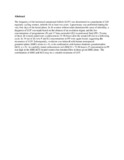| dc.contributor.author | Temmerman, M | |
| dc.contributor.author | Devroey, P | |
| dc.contributor.author | Naaktgeboren, N | |
| dc.contributor.author | Amy, JJ | |
| dc.contributor.author | Van Steirteghem, AC | |
| dc.date.accessioned | 2013-06-26T13:52:01Z | |
| dc.date.available | 2013-06-26T13:52:01Z | |
| dc.date.issued | 1984 | |
| dc.identifier.citation | Acta Eur Fertil. 1984 May-Jun;15(3):179-83 | en |
| dc.identifier.uri | http://hinari-gw.who.int/whalecomwww.ncbi.nlm.nih.gov/whalecom0/pubmed/6237540 | |
| dc.identifier.uri | http://erepository.uonbi.ac.ke:8080/xmlui/handle/123456789/40581 | |
| dc.description.abstract | The frequency of the luteinized unruptured follicle (LUF) was determined in a population of 220 regularly cycling women, infertile for at least two years. Laparoscopy was performed during the very first days of the luteal phase. In 26 women without other demonstrable cause of infertility, a diagnosis of LUF was made based on the absence of an ovulation stigma and the low concentrations of progesterone (P) and 17 beta-oestradiol (E2) in peritoneal fluid (PF). Twenty of these 26 women underwent a culdocentesis 72-96 hours after the serum LH-rise in a following cycle. In 19 out of 20, low P and E2 concentrations in PF were again found, suggesting the recurrence of LUF. Subsequently, ovulation was induced with human menopausal gonadotrophins (hMG) alone (n = 4), or in combination with human chorionic gonadotrophin (hCG, n = 9). At carefully timed culdocentesis (at LH/hCG + 72-96 hours), P concentration in PF was high in the hMG-hCG treated women but remained low in those given hMG alone. The combination of hMG and hCG may be a valuable treatment of LUF. | en |
| dc.language.iso | en | en |
| dc.title | Incidence, recurrence and treatment of the luteinized unruptured follicle syndrome. | en |
| dc.type | Article | en |
| local.publisher | Department of Obstetrics and Gynaecology, College of Health Sciences, University of Nairobi | en |

